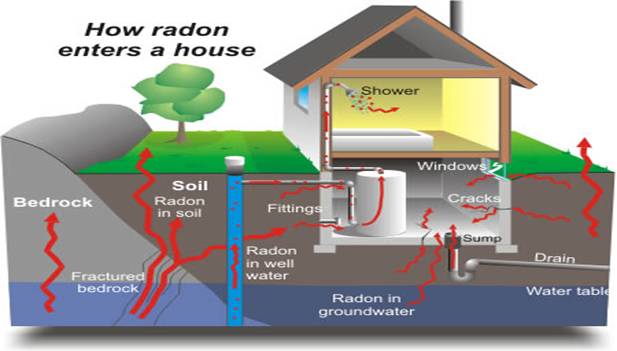Radon Detection
How Radon Gets Into Your Home

- Radon is a chemical element with symbol Rn and atomic number 86. It is a radioactive, colorless, odorless, tasteless[2] noble gas, occurring naturally as an indirect decay product of uranium or thorium. Its most stable isotope, 222Rn, has a half-life of 3.8 days. Radon is one of the densest substances that remains a gas under normal conditions. It is also the only gas under normal conditions that only has radioactive isotopes, and is considered a health hazard due to its radioactivity. Intense radioactivity has also hindered chemical studies of radon and only a few compounds are known.
- Despite its short lifetime, some radon gas from natural sources can accumulate to far higher than normal concentrations in buildings, especially in low areas such as basements and crawl spaces due to its heavy nature. It can also be found in some spring waters and hot springs.
- Epidemiological studies have shown a clear link between breathing high concentrations of radon and incidence of lung cancer. Thus, radon is considered a significant contaminant that affects indoor air quality worldwide. According to the United States Environmental Protection Agency, radon is the second most frequent cause of lung cancer, after cigarette smoking, causing 21,000 lung cancer deaths per year in the United States. About 2,900 of these deaths occur among people who have never smoked. While radon is the second most frequent cause of lung cancer, it is the number one cause among non-smokers, according to EPA estimates.
- Determining Appropriate Radon Reduction Method
- Your house type will affect the kind of radon reduction system that will work best. Radon reduction systems can be grouped by house foundation design.
- In houses that have a basement, crawlspace or a slab-on-grade foundation, radon is usually reduced by one of four types of soil suction: sub-slab suction, drain tile suction, sump hole suction or block wall suction. Active sub-slab suction (also called sub-slab depressurization) is the most common and usually the most reliable radon reduction method. One or more suction pipes are inserted through the floor slab into the crushed rock or soil underneath. They also may be inserted below the concrete slab from outside the house. The number and location of suction pipes that are needed depends on how easily air can move through the substrate under the slab. Often, only a single suction point is needed.
- Other Types of Radon Reduction Methods
- Other radon reduction techniques that can be used in any type of house include: heat recovery ventilation and natural ventilation.
- A heat recovery ventilator (HRV), also called an air-to-air heat exchanger can be installed to increase ventilation which will help reduce the radon levels in your home. An HRV will increase ventilation by introducing outdoor air while using the heated or cooled air being exhausted to warm or cool the incoming air. HRVs are more effective in reducing radon levels when used to ventilate only the basement and when the radon level is less than 10 pCi/L.
- It is a good practice to correct a radon problem before you put your house on the market. High radon levels have been known to negatively affect home sales. Radon mitigation systems do not require major changes to your home and do not adversely effect the value of your home! Homes mitigated to acceptable levels have added protection against radon and therefore make the mitigation system an excellent selling point.
- Note:
- Sealing entry points does not lower radon levels significantly or consistently and is not recommended by the EPA as the sole method for mitigation. However sealing may enhance the performance of the mitigation system.
 Call 412-207-9738.
Call 412-207-9738.